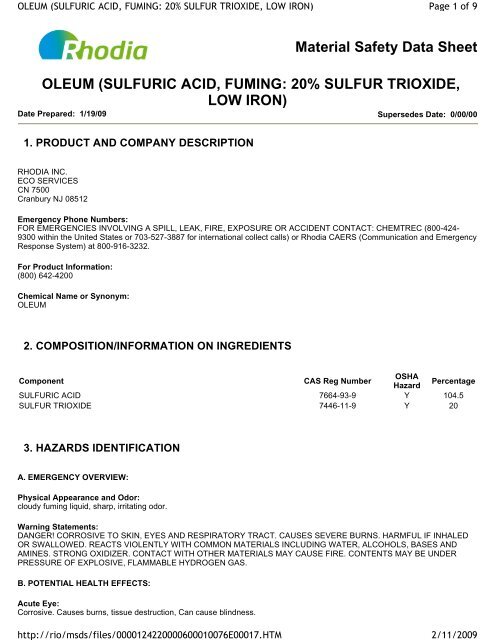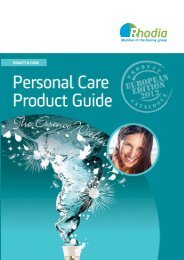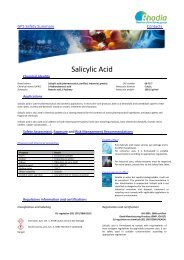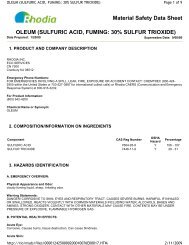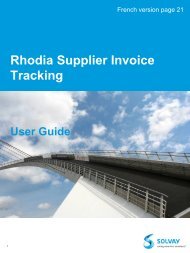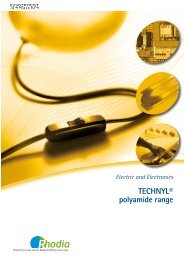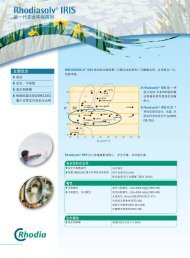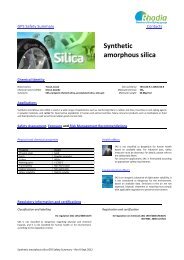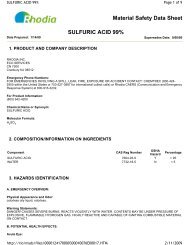Oleum 20 Low Iron - Rhodia
Oleum 20 Low Iron - Rhodia
Oleum 20 Low Iron - Rhodia
Create successful ePaper yourself
Turn your PDF publications into a flip-book with our unique Google optimized e-Paper software.
OLEUM (SULFURIC ACID, FUMING: <strong>20</strong>% SULFUR TRIOXIDE, LOW IRON)<br />
http://rio/msds/files/00001242<strong>20</strong>000600010076E00017.HTM<br />
Page 1 of 9<br />
2/11/<strong>20</strong>09<br />
<br />
Material Safety Data Sheet<br />
OLEUM (SULFURIC ACID, FUMING: <strong>20</strong>% SULFUR TRIOXIDE,<br />
LOW IRON)<br />
Date Prepared: 1/19/09 Supersedes Date: 0/00/00<br />
1. PRODUCT AND COMPANY DESCRIPTION<br />
RHODIA INC.<br />
ECO SERVICES<br />
CN 7500<br />
Cranbury NJ 08512<br />
Emergency Phone Numbers:<br />
FOR EMERGENCIES INVOLVING A SPILL, LEAK, FIRE, EXPOSURE OR ACCIDENT CONTACT: CHEMTREC (800-424-<br />
9300 within the United States or 703-527-3887 for international collect calls) or <strong>Rhodia</strong> CAERS (Communication and Emergency<br />
Response System) at 800-916-3232.<br />
For Product Information:<br />
(800) 642-4<strong>20</strong>0<br />
Chemical Name or Synonym:<br />
OLEUM<br />
2. COMPOSITION/INFORMATION ON INGREDIENTS<br />
Component<br />
CAS Reg Number<br />
OSHA<br />
Hazard<br />
Percentage<br />
SULFURIC ACID 7664-93-9 Y 104.5<br />
SULFUR TRIOXIDE 7446-11-9 Y <strong>20</strong><br />
3. HAZARDS IDENTIFICATION<br />
A. EMERGENCY OVERVIEW:<br />
Physical Appearance and Odor:<br />
cloudy fuming liquid, sharp, irritating odor.<br />
Warning Statements:<br />
DANGER! CORROSIVE TO SKIN, EYES AND RESPIRATORY TRACT. CAUSES SEVERE BURNS. HARMFUL IF INHALED<br />
OR SWALLOWED. REACTS VIOLENTLY WITH COMMON MATERIALS INCLUDING WATER, ALCOHOLS, BASES AND<br />
AMINES. STRONG OXIDIZER. CONTACT WITH OTHER MATERIALS MAY CAUSE FIRE. CONTENTS MAY BE UNDER<br />
PRESSURE OF EXPLOSIVE, FLAMMABLE HYDROGEN GAS.<br />
B. POTENTIAL HEALTH EFFECTS:<br />
Acute Eye:<br />
Corrosive. Causes burns, tissue destruction, Can cause blindness.
OLEUM (SULFURIC ACID, FUMING: <strong>20</strong>% SULFUR TRIOXIDE, LOW IRON)<br />
http://rio/msds/files/00001242<strong>20</strong>000600010076E00017.HTM<br />
Page 2 of 9<br />
2/11/<strong>20</strong>09<br />
Acute Skin:<br />
Corrosive. Causes redness, inflammation, burns.<br />
Acute Inhalation:<br />
Harmful if inhaled. Causes upper respiratory tract irritation, lung irritation, chest pain, wheezing, shortness of breath, a burning<br />
sensation, tickling of the nose and throat, sneezing, Repeated exposure to high levels of sulfuric acid mist may cause etching of<br />
tooth enamel in persons who breathe through their mouths.<br />
Acute Ingestion:<br />
Harmful if ingested. Can cause irritation, abdominal pain, corrosion.<br />
Chronic Effects:<br />
When mists are released from this product they are considered to be probable or suspected human carcinogens (see Section 11<br />
- Chronic).<br />
4. FIRST AID MEASURES<br />
FIRST AID MEASURES FOR ACCIDENTAL:<br />
Eye Exposure:<br />
Immediately flush the eyes with a steady, gentle stream of running water for at least 15 minutes. Hold the eyelids apart during<br />
the irrigation to ensure flushing of the entire surface of the eye and lids with water. obtain medical attention, preferably from an<br />
opthalmologist. Oils or ointments should not be applied unless directed by physician. Continue the irrigation for an additional 15<br />
minutes if a physician is not immediately available.<br />
Skin Exposure:<br />
Immediately wipe excess material off the skin with a dry cloth and flush affected areas with plenty of water for 15 minutes.<br />
Remove contaminated clothing while under the shower. Continue washing with water. Do not attempt to neutralize with chemical<br />
agents. Obtain medical attention.<br />
Inhalation:<br />
Remove the person from contaminated atmosphere and assure that the victim is breathing. If breathing has ceased, start<br />
artificial respiration. Oxygen, if available, should only be administered by a qualified technician under the direction of a physician.<br />
Keep warm and comfortable. Obtain medical attention immediately.<br />
Ingestion:<br />
DO NOT INDUCE VOMITING. If the person is conscious and has no trouble breathing a small (no more than one glass) amount<br />
of water may be given. Do not leave victim unattended. To prevent aspiration of the swallowed product, lay victim on side with<br />
head lower than waist. If vomiting occurs do not re-administer water. Do not give anything by mouth to an unconscious person.<br />
IMMEDIATELY obtain medical attention.<br />
MEDICAL CONDITIONS POSSIBLY AGGRAVATED BY EXPOSURE:<br />
Inhalation of product may aggravate existing chronic respiratory problems such as asthma, emphysema or bronchitis. Skin<br />
contact may aggravate existing skin disease.<br />
NOTES TO PHYSICIAN:<br />
All treatments should be based on observed signs and symptoms of distress in the patient. Consideration should be given to the<br />
possibility that overexposure to materials other than this product may have occurred.<br />
This material is an acid. The primary toxicity of this product is due to its irritant effects on mucous membranes.<br />
INHALATION: If cough or shortness of breath occurs, evaluate the possibility of bronchitis or pneumonitis. Chest x-ray and<br />
arterial blood gases can be used to determine the presence of pulmonary edema. In severe cases, use of humidified oxygen<br />
and assisted ventilation including positive end expiratory pressure (PEEP) may be needed. Parenteral steroids may be useful in<br />
limiting the extent of pulmonary damage.<br />
SKIN: Wash exposed area thoroughly with soap and water. Chemical burns from strong acids are generally treated the same as<br />
thermal burns.
http://rio/msds/files/00001242<strong>20</strong>000600010076E00017.HTM<br />
2/11/<strong>20</strong>09<br />
OLEUM (SULFURIC ACID, FUMING: <strong>20</strong>% SULFUR TRIOXIDE, LOW IRON)<br />
Page 3 of 9<br />
EYES: Irrigate eyes for 15 minutes with sterile saline. If irritation, pain, swelling, photophobia or lacrimation persist, examination<br />
by an ophthalmologist is recommended.<br />
INGESTION: If not already performed by first aid personnel, irrigate mouth with large amounts of water and dilute the acid by<br />
having victim drink 4 to 8 ounces of water or milk. DO NOT induce vomiting. Use of gastric lavage is controversial. The<br />
advantage of removal of acid must be weighted against the risk of perforation or bleeding. If a large amount of acid (> 1 ml/kg<br />
body weight) has been recently ingested, cautious gastric lavage is generally advised if the patient is alert and there is little risk<br />
of convulsions. Consultation with a gastroenterologist and/or surgeon is advised. Serious complications such as perforation or<br />
stricture of the esophagus may occur requiring care by specialists. Laryngeal edema may develop requiring intubation or<br />
tracheostomy.<br />
5. FIRE FIGHTING MEASURES<br />
FIRE HAZARD DATA:<br />
Flash Point:<br />
Not Applicable<br />
Extinguishing Media:<br />
Not combustible. Use extinguishing method suitable for surrounding fire. Recommended (small fires): dry chemical, carbon<br />
dioxide, Recommended (large fire): dry sand, water spray (massive amount), Not recommended: water (unless large excess is<br />
possible).<br />
Special Fire Fighting Procedures:<br />
Firefighters should wear NIOSH/MSHA approved positive pressure breathing apparatus with full face-piece and full acidresistant<br />
protective clothing. Fight fire from maximum distance.<br />
Unusual Fire and Explosion Hazards:<br />
Not combustible. Strong oxidizers can react with reducing agents or combustibles producing heat and causing ignition. Reacts<br />
violently with water releasing heat and corrosive material. The addition of water into a ruptured tank may cause an explosion and<br />
the formation of a thick cloud of corrosive, highly toxic smoke capable of travelling long distances.<br />
Hazardous Decomposition Materials (Under Fire Conditions):<br />
oxides of sulfur<br />
6. ACCIDENTAL RELEASE MEASURES<br />
Evacuation Procedures and Safety:<br />
Personnel handling this material should be thoroughly trained to handle spills and releases. Do not direct hose streams into an<br />
unignited transportation spill (tank truck or tank car).<br />
Containment of Spill:<br />
Stop leak if it can be done without risk. Dike spill using absorbent or impervious materials such as earth, sand or clay. Dike or<br />
retain dilution water or water from firefighting for later disposal.<br />
Cleanup and Disposal of Spill:<br />
Pump any free liquid into an appropriate closed container (see Section 7: Handling and Storage). Exercise caution during<br />
neutralization as considerable heat may be generated. Neutralize spill area with soda ash, sodium bicarbonate or lime.<br />
Environmental and Regulatory Reporting:<br />
Large spills should be handled according to a predetermined plan. For assistance in developing a plan contact the Technical<br />
Service Department using the Product Information phone number in Section 1. Do not flush to drain. Runoff from fire control or<br />
dilution water may cause pollution. Dispose of as a hazardous waste. Spills may be reportable to the National Response Center<br />
(800-424-8802) and to state and/or local agencies.
OLEUM (SULFURIC ACID, FUMING: <strong>20</strong>% SULFUR TRIOXIDE, LOW IRON)<br />
http://rio/msds/files/00001242<strong>20</strong>000600010076E00017.HTM<br />
Page 4 of 9<br />
2/11/<strong>20</strong>09<br />
7. HANDLING AND STORAGE<br />
Minimum/Maximum Storage Temperatures:<br />
Not Available<br />
Handling:<br />
Do not breathe vapors and mists. Do not get on skin or in eyes. This product reacts violently with bases liberating heat and<br />
causing spattering.<br />
When diluting an acid, ALWAYS add the acid slowly to water and stir well to avoid spattering. NEVER ADD WATER TO ACID.<br />
Storage:<br />
Store in tightly closed containers. Store in an area that is dry, well-ventilated, Freezing point varies with concentration. Maximum<br />
recommended storage temperature = 104F (40C). Corrosion rates increase at elevated temperatures.<br />
8. EXPOSURE CONTROLS/PERSONAL PROTECTION<br />
Introductory Remarks:<br />
These recommendations provide general guidance for handling this product. Because specific work environments and material<br />
handling practices vary, safety procedures should be developed for each intended application. While developing safe handling<br />
procedures, do not overlook the need to clean equipment and piping systems for maintenance and repairs. Waste resulting from<br />
these procedures should be handled in accordance with Section 13: Disposal Considerations.<br />
Assistance with selection, use and maintenance of worker protection equipment is generally available from equipment<br />
manufacturers.<br />
Exposure Guidelines:<br />
Exposure limits represent regulated or recommended worker breathing zone concentrations measured by validated sampling<br />
and analytical methods, meeting the regulatory requirements. The following limits apply to this material, where, if indicated,<br />
S=skin and C=ceiling limit:<br />
SULFURIC ACID<br />
ACGIH<br />
OSHA<br />
RHODIA<br />
Notes TWA STEL<br />
0.2 mg/cu m<br />
1 mg/cu m<br />
0.3 mg/cu m<br />
Engineering Controls:<br />
Where engineering controls are indicated by use conditions or a potential for excessive exposure exists, the following traditional<br />
exposure control techniques may be used to effectively minimize employee exposures: local exhaust ventilation at the point of<br />
generation.<br />
Respiratory Protection:<br />
When respirators are required, select NIOSH/MSHA approved equipment based on actual or potential airborne concentrations<br />
and in accordance with the appropriate regulatory standards and/or industrial recommendations.<br />
If the exposure limit is exceeded and engineering controls are not feasible, a full facepiece respirator with an acid gas cartridge<br />
and particulate filter (NIOSH type N100 filter) may be worn up to 50 times the exposure limit, or the maximum use concentration<br />
specified by the appropriate regulatory agency or respirator supplier, whichever is lowest. If oil particles (e.g. lubricants, cutting<br />
fluids, glycerine, etc.) are present, use a NIOSH type R or P particulate filter. WARNING: Air purifying respirators do not protect<br />
workers in oxygen-deficient atmospheres. For emergencies or instances where the exposure levels are not known, use a fullfacepiece<br />
positive-pressure, air-supplied respirator.<br />
Eye/Face Protection:<br />
Eye and face protection requirements will vary dependent upon work environment conditions and material handling practices.<br />
Appropriate ANSI Z87 approved equipment should be selected for the particular use intended for this material. Contact to face<br />
and eyes should be prevented through use of a face shield and splash proof goggles. An emergency eye wash must be readily<br />
accessible to the work area.
OLEUM (SULFURIC ACID, FUMING: <strong>20</strong>% SULFUR TRIOXIDE, LOW IRON)<br />
http://rio/msds/files/00001242<strong>20</strong>000600010076E00017.HTM<br />
Page 5 of 9<br />
2/11/<strong>20</strong>09<br />
Skin Protection:<br />
Skin contact must be prevented through the use of permeation resistant clothing, gloves and footwear, selected with regard for<br />
use conditions and exposure potential. An emergency shower must be readily accessible to the work area. Consideration must<br />
be given both to durability as well as permeation resistance.<br />
Work Practice Controls:<br />
Personal hygiene is an important work practice exposure control measure and the following general measures should be taken<br />
when working with or handling this material:<br />
(1) Do not store, use, and/or consume foods, beverages, tobacco products, or cosmetics in areas where this material<br />
is stored.<br />
(2) Wash hands and face carefully before eating, drinking, using tobacco, applying cosmetics, or using the toilet.<br />
(3) Wash exposed skin promptly to remove accidental splashes or contact with this material.<br />
9. PHYSICAL AND CHEMICAL PROPERTIES<br />
Physical and Chemical properties here represent typical properties of this product. Contact the business area using the Product<br />
Information phone number in Section 1 for its exact specifications.<br />
Physical Appearance:<br />
cloudy fuming liquid.<br />
Odor:<br />
sharp, irritating odor.<br />
pH:<br />
< 1 at 1 wt/wt%.<br />
Specific Gravity:<br />
1.916 at 4 C (39 F).<br />
Water Solubility:<br />
miscible<br />
Melting Point Range:<br />
Not Available<br />
Freezing Point Range:<br />
1 C (34 F)<br />
Boiling Point Range:<br />
140 C (284 F) at 760 mmHg<br />
Vapor Pressure:<br />
1.1 mmHg at <strong>20</strong> C (68 F)<br />
Vapor Density:<br />
2.8<br />
Evaporation Rate:<br />
0.56 (Butyl Acetate = 1)<br />
10. STABILITY AND REACTIVITY<br />
Chemical Stability:<br />
This material is stable under normal handling and storage conditions described in Section 7.
OLEUM (SULFURIC ACID, FUMING: <strong>20</strong>% SULFUR TRIOXIDE, LOW IRON)<br />
http://rio/msds/files/00001242<strong>20</strong>000600010076E00017.HTM<br />
Page 6 of 9<br />
2/11/<strong>20</strong>09<br />
Conditions To Be Avoided:<br />
water<br />
Materials/Chemicals To Be Avoided:<br />
water<br />
strong reducing agents<br />
halogens<br />
bases<br />
metals<br />
nitrogen compounds<br />
The Following Hazardous Decomposition Products Might Be Expected:<br />
Decomposition Type: thermal<br />
oxides of sulfur<br />
Hazardous Polymerization Will Not Occur.<br />
Avoid The Following To Inhibit Hazardous Polymerization:<br />
not applicable<br />
11. TOXICOLOGICAL INFORMATION<br />
Acute Eye Irritation:<br />
The following data are for similar or related products.<br />
Toxicological Information and Interpretation:<br />
eye - eye irritation, 250 ug/24 hr, rabbit. Severely irritating. Data for sulfuric acid.<br />
Acute Skin Irritation:<br />
No test data found for product. This product was not tested because strong acids are known to be corrosive and to cause severe<br />
tissue destruction.<br />
Acute Dermal Toxicity:<br />
No test data found for product. This product was not tested because strong bases are known to be corrosive and to cause<br />
severe tissue destruction.<br />
Acute Respiratory Irritation:<br />
The following data is for similar or related products.<br />
Toxicological Information and Interpretation:<br />
lung - lung irritation, < 5 mg/cu m, human. Mildly irritating. Data for sulfuric acid.<br />
Acute Inhalation Toxicity:<br />
The following data is for similar or related products.<br />
Toxicological Information and Interpretation:<br />
LC50 - lethal concentration 50% of test species, 347 ppm/1 hr, rat. Data for sulfuric acid.<br />
LC50 - lethal concentration 50% of test species, 510 mg/cu m/2 hr, rat. Data for sulfuric acid.<br />
Acute Oral Toxicity:<br />
The following data is for similar or related products.<br />
Toxicological Information and Interpretation:<br />
LD50 - lethal dose 50% of test species, 2140 mg/kg, rat. Data for sulfuric acid.<br />
Chronic Toxicity:<br />
This product contains the substances that are considered to be "probable" or "suspected" human carcinogens as follows:<br />
The International Agency for Research on Cancer (IARC) and the National Toxicology Program (NTP) have classified<br />
"occupational exposure to strong inorganic acid mists containing sulfuric acid" as a known human carcinogen (IARC Category
http://rio/msds/files/00001242<strong>20</strong>000600010076E00017.HTM<br />
2/11/<strong>20</strong>09<br />
OLEUM (SULFURIC ACID, FUMING: <strong>20</strong>% SULFUR TRIOXIDE, LOW IRON)<br />
Page 7 of 9<br />
1). This classification applies only to sulfuric acid when generated as a mist. There is still debate in the scientific community<br />
whether the studies reviewed by IARC and NTP adequately controlled for confounding occupational exposures and personal<br />
habits such as cigarette smoking and alcohol consumption. A few epidemiology studies have suggested a possible association<br />
between sulfuric acid exposure and laryngeal or lung cancer; however, in all these studies, workers were exposed to many other<br />
chemicals, some of which are recognized carcinogens, such as diethylsulfate and nickel. Considering the multiple chemical<br />
exposures and other limitations of the studies, we disagree with IARC's conclusion that a cause and effect relationship between<br />
cancer and "occupational exposure to strong inorganic acid mist containing sulfuric acid" has been demonstrated. Also more<br />
recent epidemiological studies have failed to find any association between "occupational exposure to strong inorganic acid mist<br />
containing sulfuric acid" and laryngeal or lung cancer. ACGIH has classified "sulfuric acid as contained in strong inorganic acid<br />
mists" as a suspect human carcinogen. This classification does not apply to sulfuric acid per se. Lifetime animal studies in<br />
hamsters, rats and guinea pigs were conducted in the 1970's under sponsorship of the Environmental Protection Agency (EPA)<br />
or the National Institutes of Environmental Health Sciences (NIEHS). All three lifetime studies were negative for carcinogenic<br />
effects. These studies were not formally published by the government agencies because they were satisfied that sulfuric acid<br />
mist was not a carcinogenic problem. Because these studies were not published, IARC or NTP did not consider them in their<br />
deliberations.<br />
Regulatory Agency Listing Carcinogen<br />
Ingredient Name OSHA IARC NTP ACGIH<br />
OCCUPATIONAL EXPOSURES TO STRONG-INORGANIC-AC<br />
ID MISTS CONTAINING<br />
No 1 Yes A2<br />
12. ECOLOGICAL INFORMATION<br />
Ecotoxicological Information:<br />
Ecotoxological Information and Interpretation:<br />
The toxicity of sulfuric acid to fish is dependent on the resulting pH of the water. lethality at a pH of 5.0 or below. required to<br />
cause lethality varies depending on the hardness of the water (hard water has some buffering capacity) and the species of fish<br />
(some fish are more resistant to the effects of acidity). McKee, JE, and Wolf, HA (Editors), Water Quality Criteria, 2nd ed.,<br />
Publication No. 3-A, p. 279, California State Water Resources Control Board, Sacramento, CA (rev. 1963).<br />
Chemical Fate Information:<br />
No data found for product.<br />
13. DISPOSAL CONSIDERATIONS<br />
Waste Disposal Method:<br />
Chemical additions, processing or otherwise altering this material may make the waste management information presented in<br />
this MSDS incomplete, inaccurate or otherwise inappropriate. Please be advised that state and local requirements for waste<br />
disposal may be more restrictive or otherwise different from federal laws and regulations. Consult state and local regulations<br />
regarding the proper disposal of this material.<br />
Container Handling and Disposal:<br />
Rinse containers before disposal.<br />
EPA Hazardous Waste - YES<br />
EPA RCRA HAZARDOUS WASTE CODES:<br />
"C" Corrosive; "R" Reactive.<br />
14. TRANSPORTATION INFORMATION
OLEUM (SULFURIC ACID, FUMING: <strong>20</strong>% SULFUR TRIOXIDE, LOW IRON)<br />
http://rio/msds/files/00001242<strong>20</strong>000600010076E00017.HTM<br />
Page 8 of 9<br />
2/11/<strong>20</strong>09<br />
Transportation Status: IMPORTANT! Statements below provide additional data on listed DOT classification.<br />
The listed Transportation Classification does not address regulatory variations due to changes in package size, mode of<br />
shipment or other regulatory descriptors.<br />
US Department of Transportation<br />
Hazard Class..... 8<br />
Shipping Name:<br />
SULFURIC ACID, FUMING<br />
ID Number....... UN1831<br />
Packing Group.... I<br />
Labels........... CORROSIVE<br />
Emergency Guide #.... 137<br />
15. REGULATORY INFORMATION<br />
Inventory Status<br />
Inventory Status<br />
UNITED STATES (TSCA)<br />
Y<br />
CANADA (DSL)<br />
Y<br />
EUROPE (EINECS/ELINCS)<br />
Y<br />
AUSTRALIA (AICS)<br />
Y<br />
JAPAN (MITI)<br />
Y<br />
SOUTH KOREA (KECL)<br />
Y<br />
Y = All ingredients are on the inventory.<br />
E = All ingredients are on the inventory or exempt from listing.<br />
P = One or more ingredients fall under the polymer exemption or are on the no longer polymer list. All other ingredients are on<br />
the inventory or exempt from listing.<br />
N = Not determined or one or more ingredients are not on the inventory and are not exempt from listing.<br />
FEDERAL REGULATIONS<br />
Inventory Issues:<br />
All functional components of this product are listed on the TSCA Inventory.<br />
SARA Title III Hazard Classes:<br />
Fire Hazard<br />
Reactive Hazard<br />
Release of Pressure<br />
Acute Health Hazard<br />
Chronic Health Hazard<br />
- NO<br />
- YES<br />
- NO<br />
- YES<br />
- NO<br />
SARA 313 Chemicals<br />
SULFURIC ACID (104.5%)<br />
SARA Extremely Hazardous Substances (EHS)/CERCLA Hazardous Substances<br />
Ingredient CERCLA/SARA RQ SARA EHS TPQ<br />
SULFURIC ACID 1000 lbs 1000 lbs<br />
SULFUR TRIOXIDE<br />
100 lbs<br />
UNLISTED HAZARDOUS WASTES - CHARACTERISTIC OF<br />
CORROSIVITY<br />
100 lbs<br />
UNLISTED HAZARDOUS WASTES - CHARACTERISTIC OF REACTIVITY 100 lbs<br />
STATE REGULATIONS:<br />
This product contains the following components that are regulated under California Proposition 65:<br />
Ingredient Name Cancer Reprod. No Sign. Risk Lvl (ug/day)
OLEUM (SULFURIC ACID, FUMING: <strong>20</strong>% SULFUR TRIOXIDE, LOW IRON)<br />
http://rio/msds/files/00001242<strong>20</strong>000600010076E00017.HTM<br />
Page 9 of 9<br />
2/11/<strong>20</strong>09<br />
OCCUPATIONAL EXPOSURES TO STRONG-INORGANIC-<br />
AC ID MISTS CONTAINING SULFU<br />
List List California RPI<br />
Y N ND ND<br />
16. OTHER INFORMATION<br />
National Fire Protection Association Hazard Ratings--NFPA(R):<br />
3 Health Hazard Rating--Serious<br />
0 Flammability Rating--Minimal<br />
2 Instability Rating--Moderate<br />
0 * NO WATER<br />
National Paint & Coating Hazardous Materials Identification System--HMIS(R):<br />
3 Health Hazard Rating--Serious<br />
0 Flammability Rating--Minimal<br />
2 Reactivity Rating--Moderate<br />
Reason for Revisions:<br />
New product MSDS.<br />
Key Legend Information:<br />
ACGIH - American Conference of Governmental Industrial Hygienists<br />
OSHA - Occupational Safety and Health Administration<br />
TLV - Threshold Limit Value<br />
PEL - Permissable Exposure Limit<br />
TWA - Time Weighted Average<br />
STEL - Short Term Exposure Limit<br />
NTP - National Toxicology Program<br />
IARC - International Agency for Research on Cancer<br />
ND - Not determined<br />
RHODIA - <strong>Rhodia</strong> Established Exposure Limits<br />
Disclaimer:<br />
The information herein is given in good faith but no warranty, expressed or implied, is made.<br />
** End of MSDS Document **


